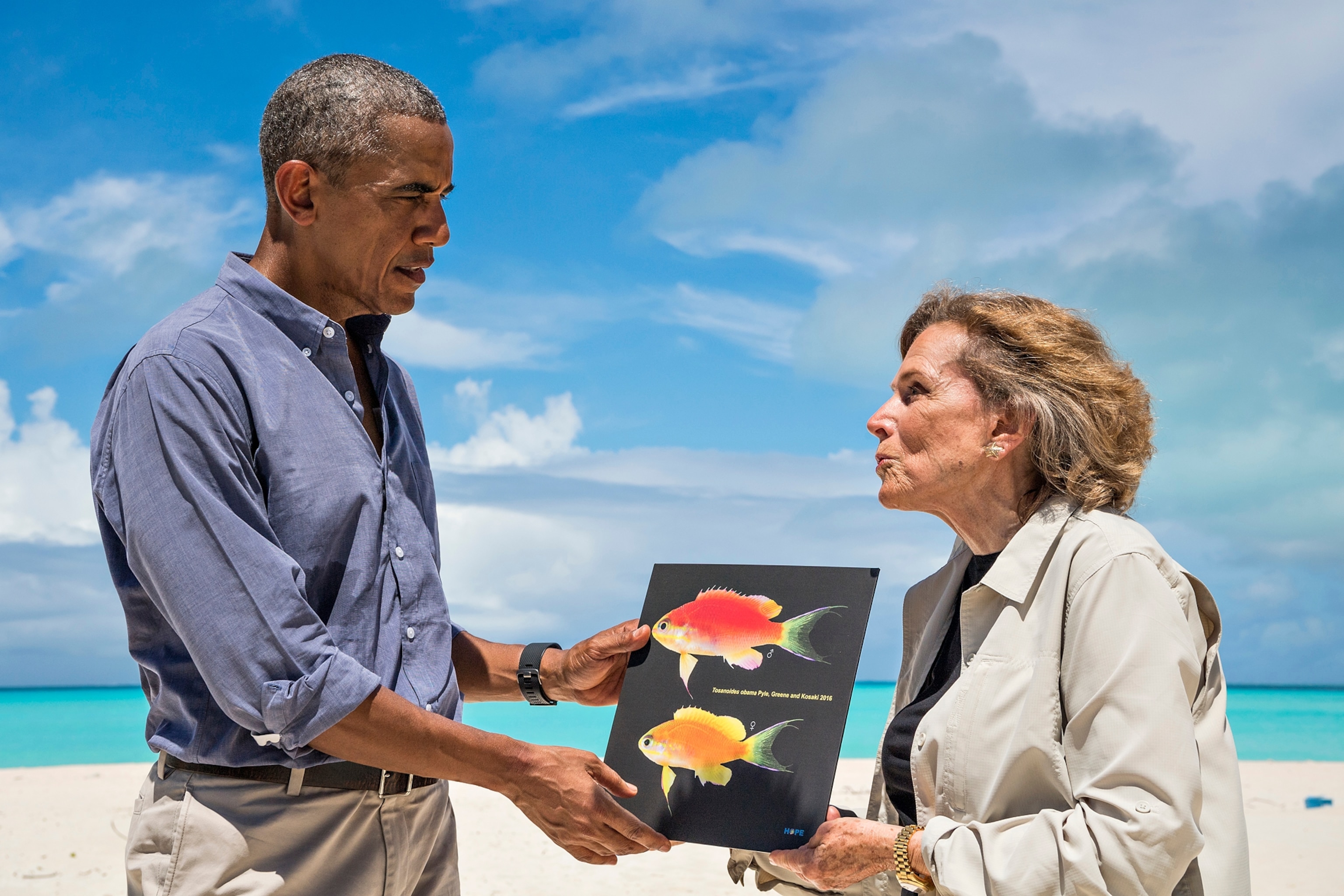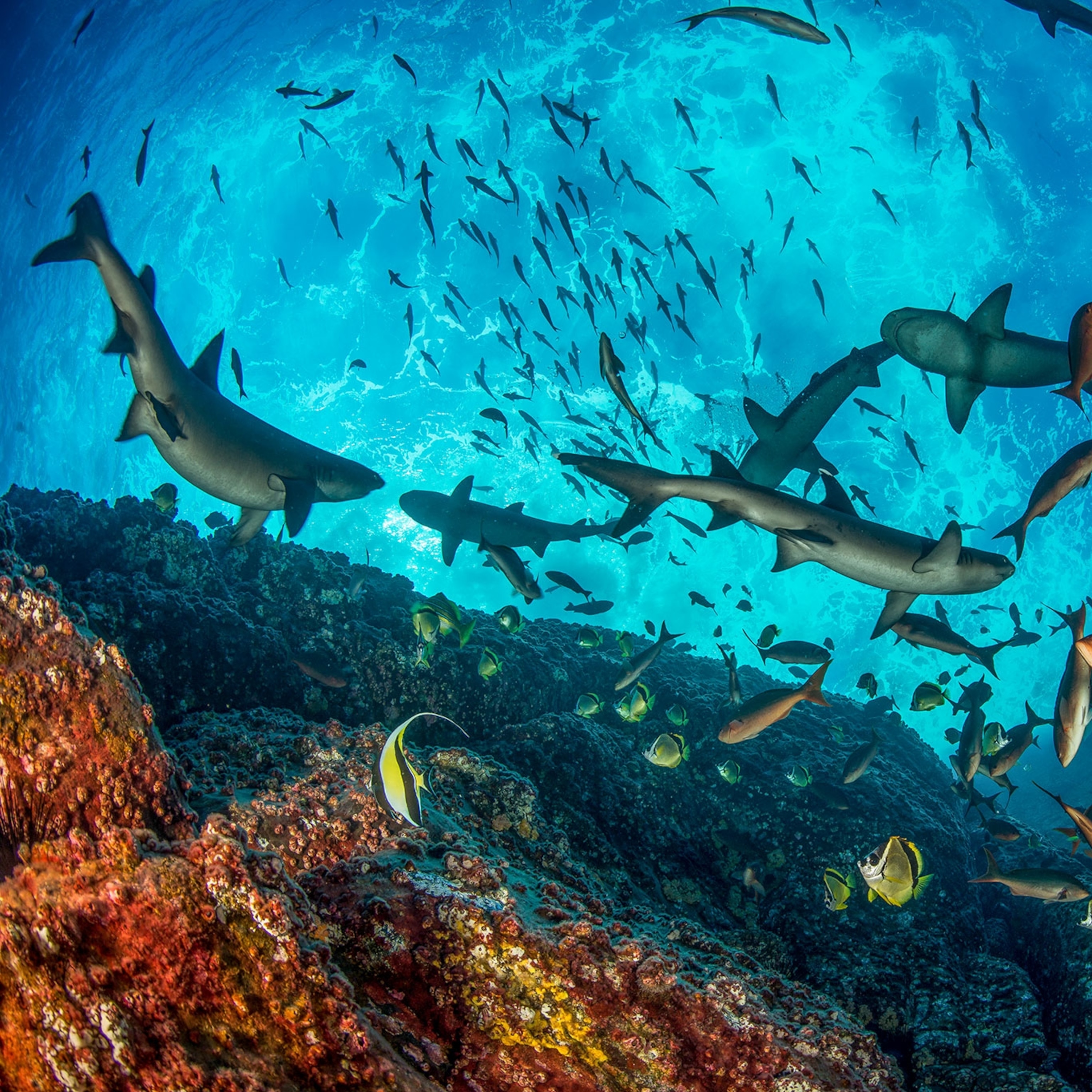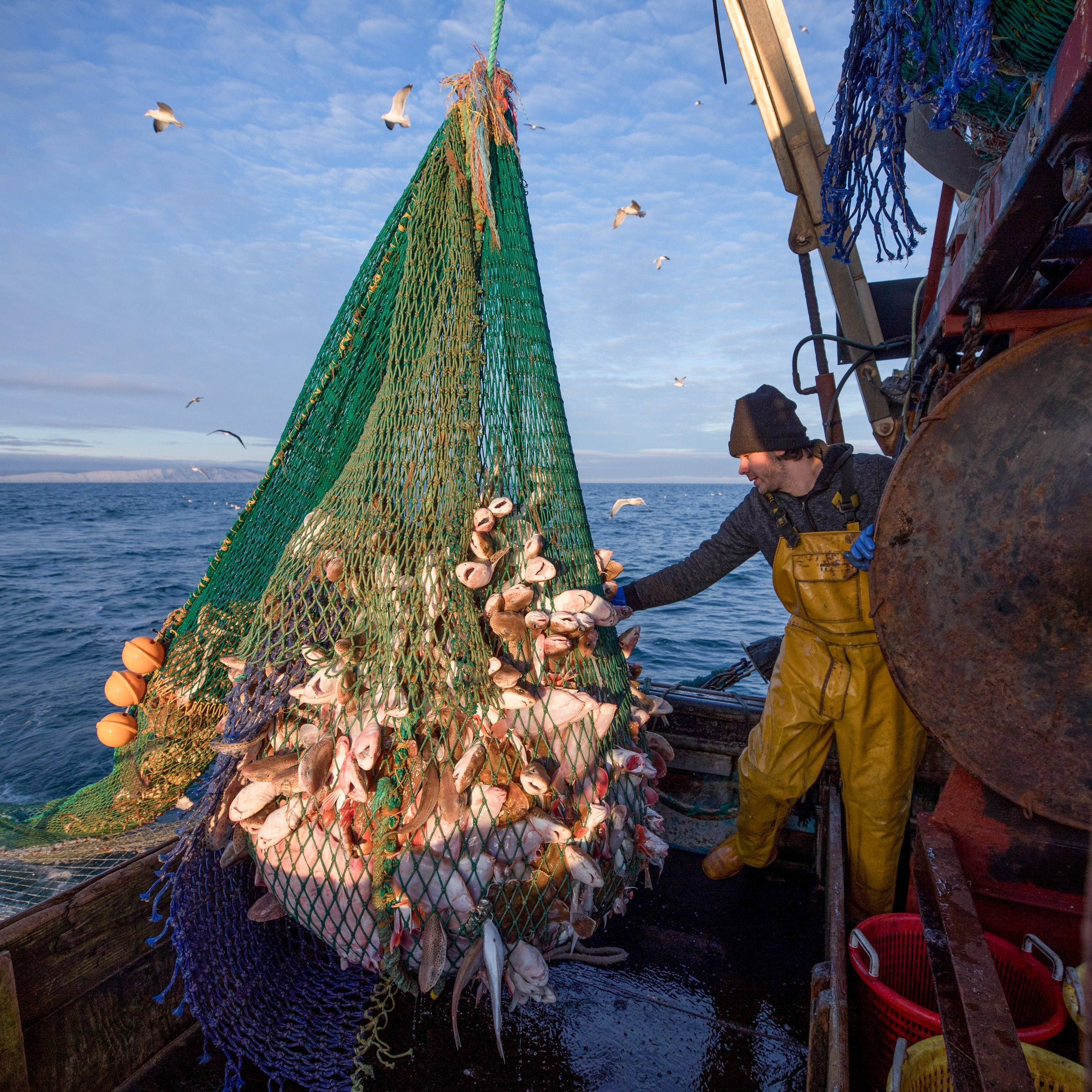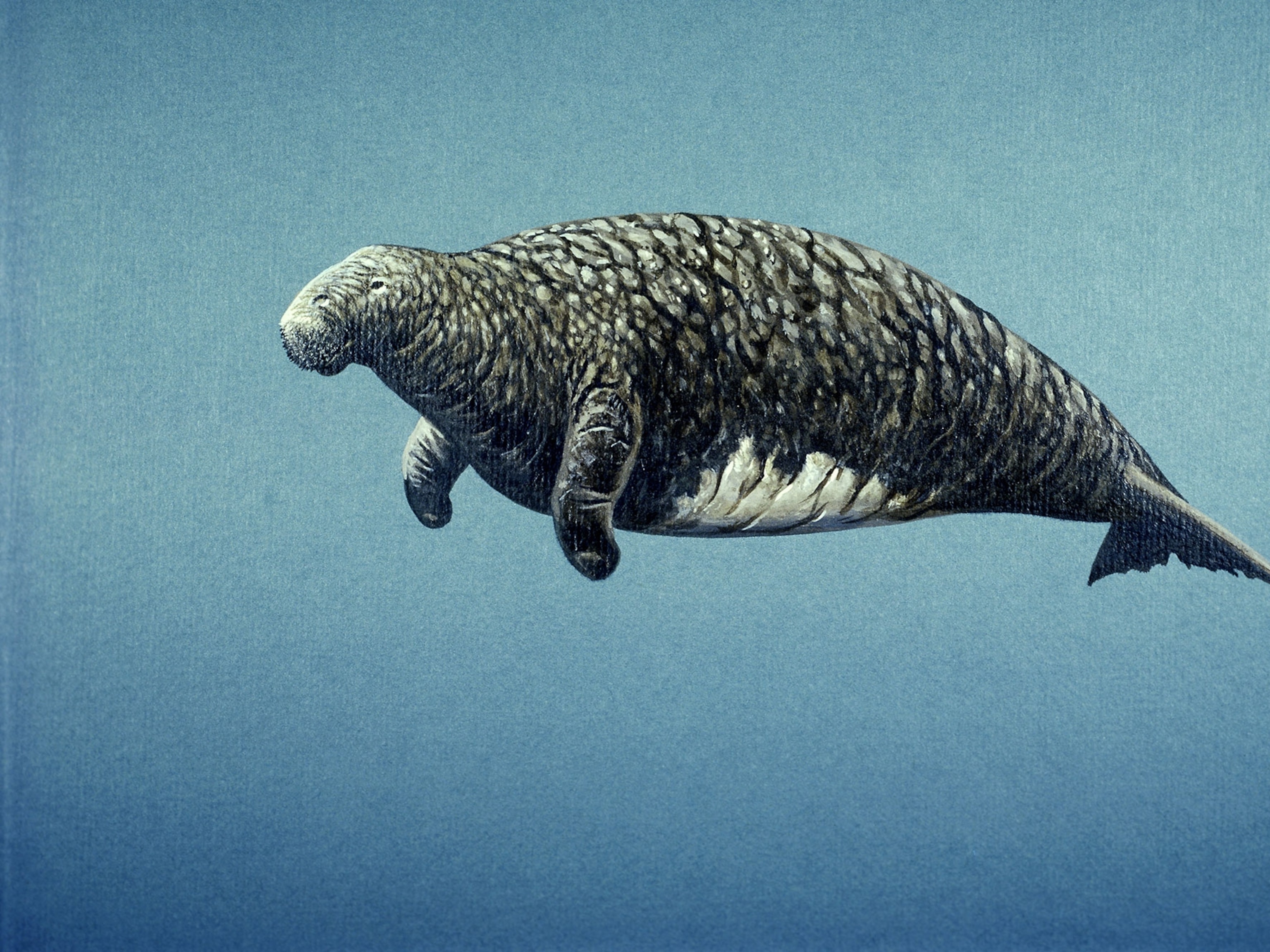
A Fish Called Obama—Newly Discovered Species Named for President
In tribute to his marine conservation efforts in the Pacific, scientist names new species after Hawaii-born president.
MIDWAY ATOLL, Pacific Ocean—The maroon and gold creature was found 300 feet deep in the waters off Kure Atoll. It's the one fish known to live only within the Papahānaumokuākea Marine National Monument, a pristine expanse of coral reefs and seamounts home to millions of seabirds, endangered turtles, endangered monk seals, and more than 7,000 species.
So scientists thought it only fitting to name this fish, in the genus Tosanoides, after President Barack Obama, who dramatically expanded Papahānaumokuākea in August 2016, creating the largest swath of protected land or water on Earth, an area roughly twice the size of Texas.
On Midway Atoll on September 1, 2016, with a Hawaiian monk seal watching from the beach, National Geographic Explorer-in-Residence Sylvia Earle—a persistent presence in conservationists’ decades-long push to protect these pristine waters—presented the Hawaii-born president with a framed plaque of his new namesake marine species. (Read our exclusive Obama interview.)

"Am I wrong here, or is there a familiar name in the middle of this?" Obama asked, as Earle handed him the rendering. "This is a nice-looking fish."
The species was discovered on June 5, 2016, during a research trip to Kure, the world’s northernmost atoll. The atoll’s deep-water reefs, among the jewels of Papahānaumokuākea, hold a special biological distinction: The 17 genera and 22 species that live on them occur only in the northwest Hawaiian Islands, giving Kure Atoll the highest rate of marine endemism ever recorded. No other place in the sea has a higher rate of species found only there.
Richard Pyle, a marine biologist with Hawaii’s Bishop Museum, was underwater when he first saw a group of orange-pink fish he didn’t recognize. Within minutes, he collected a male specimen for further analysis; a female specimen was collected a few days later by Bishop Museum affiliate Brian Greene at an atoll about 155 miles from Kure.
Later, Pyle and his colleagues confirmed that the fish represented a new species, the first member of the genus Tosanoides found outside of the waters off Japan. And on December 21, the scientists unveiled their formal description of the species in the scientific journal ZooKeys—officially naming the fish Tosanoides obama.
The male’s distinctive dorsal fin coloration, a circular red spot ringed with blue, hastened the team’s decision to honor Obama.
“It’s very reminiscent of Obama’s [campaign] logo,” Pyle says. “How appropriate that a fish we were thinking about naming after him anyway, just to say thank you for expanding the national monument, happens to have a feature that ties it to the president.
“Every other fish we’ve documented up there also occurs in the main Hawaiian Islands outside the monument,” Pyle says. The new species “is kind of like the king of the kingdom of endemics.”
‘It’s Such a Gift!’
Earle, a longtime champion of protecting marine areas, has spent countless hours diving among the sea turtles and walking alongside the millions of spectacular albatross on Midway. If she was excited to shake hands with the president on the atoll's 1,200-acre Sand Island, the feeling certainly appeared to be mutual.
As the president approached her, the emerald sea behind them, he told Earle he had been reading about her decades of work trying to save the seas.
"I am in awe of anybody who has done so much for ocean conservation," Obama said.
"It's a good start," Earle demurred.
"Listen, it's better than a good start," the president told Earle. "You've done amazing work."
Earle used the opportunity to talk about not just the loss of shallow coral reefs around the world, but also about how the healthier deep coral reefs in places like Papahānaumokuākea can help stem some of the losses. But mostly she thanked the president for his work on the monument.
"It's such a gift!" she told him, with a pump of her fist.
Honoring Presidents With Fish, Bugs, and Trees
This is the second time the president has had a fish named after him.
In 2012, scientists named a small aqua and orange speckled freshwater darter endemic to a few select drainages of the Tennessee River Etheostoma Obama. The researchers said they wanted to honor Obama for his environmental leadership, particularly on clean energy. At the time, they also named others of the more than 200 species of darters after former presidents Jimmy Carter, Theodore Roosevelt, and Bill Clinton. Another darter was named for former Vice President Al Gore, in honor of his work on climate change.
Many other U.S. presidents have had species named after them. There’s a deer named for Roosevelt, often considered the godfather of the U.S. National Park Service, which celebrated its 100th anniversary last week. There’s a tree named for Franklin Roosevelt and a palm named for George Washington.
Scientists must follow a rigorous procedure before earning the right to name a species they’ve discovered. First, they need to prove that the species is actually new by consulting with colleagues, researching historical literature, examining related specimens in museums, and scrutinizing DNA.
After that, if they’re confident the species has not yet been named, they publish their findings in a peer-reviewed scientific journal.
Then they can select a name for posterity—perhaps reflecting a unique physical characteristic, the place where the organism was found, or honoring a real or fictional person. Scientists are expected to follow guidelines and rules, which are published by the International Commission of Zoological Nomenclature (ICZN).
Naming a new species “combines two of the most difficult types of writing: the technical description and the poem,” writes Judith Winston, a curator of marine biology at the Virginia Museum of Natural History, who is on the board of the ICZN. That philosophy has yielded such memorable species as Vampyroteuthis infernalis (vampire squid from hell).
And, all names must be Latinized, which is why we have beetles known as Agra schwarzeneggeri (inspired by the beetles’ resemblance to a body builder’s bulging bicep, it’s a tribute to actor Arnold Schwarzenegger, a former body builder and California governor) and Agathidium vaderi (in honor of the infamous Star Wars villain, Darth Vader).
For his part, Obama also has a trapdoor spider, a species of lichen, a puffbird, a parasitic hairworm that infects crickets, and an extinct lizard called Obamadon named after him.
Other government officials also have inspired new species names in recent years. In 2005, Quentin Wheeler, director of the International Institute for Species Exploration in Arizona, named three species of slime mold beetle after then President George W. Bush, his vice president, Dick Cheney, and his secretary of defense, Donald Rumsfeld. Wheeler said he meant it as a compliment.
Michael Greshko and Mark Strauss contributed to this reporting.
Editor's note: This piece has been updated to reflect the location where the female specimen was collected. On December 21, 2016, this piece was updated further to include the formal scientific description of the species.







